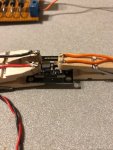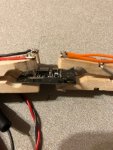reloader45
Active member
- Joined
- Mar 17, 2019
- Messages
- 172
- Points
- 28
Hello,
today I had bad luck again with a 500 mA buck/boost driver. It was not from DTR!
I connected the new driver to my dummy load of 6 diodes and a 0,1 Ohm resistor. Nothing happens, no curent draw from my laboratory power device.
After checking the wiring, the same result. Is it possible to kill the driver while soldering?
After building a working test device for laser diodes with a LM 317, I will build a test device for laser diodes drivers without soldering.
The quality laser drivers are simply to expensive to play the private laser diode driver tester.
best regards
Edgar
today I had bad luck again with a 500 mA buck/boost driver. It was not from DTR!
I connected the new driver to my dummy load of 6 diodes and a 0,1 Ohm resistor. Nothing happens, no curent draw from my laboratory power device.
After checking the wiring, the same result. Is it possible to kill the driver while soldering?
After building a working test device for laser diodes with a LM 317, I will build a test device for laser diodes drivers without soldering.
The quality laser drivers are simply to expensive to play the private laser diode driver tester.
best regards
Edgar






